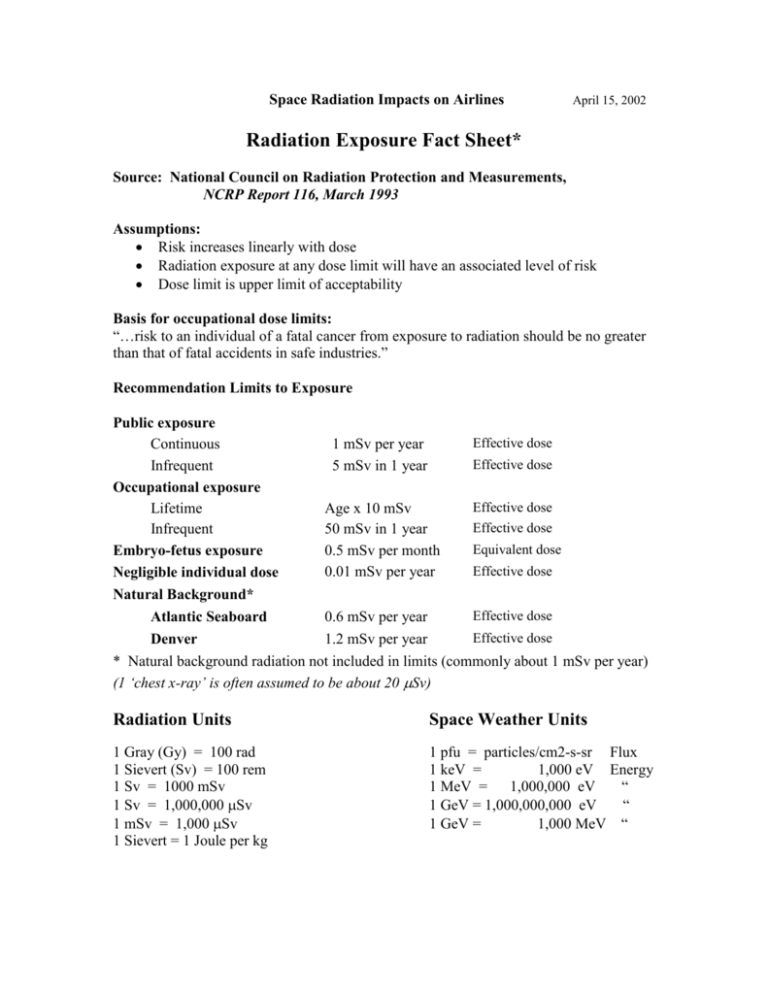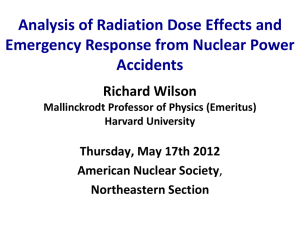Radiation Exposure Fact Sheet
advertisement

Space Radiation Impacts on Airlines April 15, 2002 Radiation Exposure Fact Sheet* Source: National Council on Radiation Protection and Measurements, NCRP Report 116, March 1993 Assumptions: Risk increases linearly with dose Radiation exposure at any dose limit will have an associated level of risk Dose limit is upper limit of acceptability Basis for occupational dose limits: “…risk to an individual of a fatal cancer from exposure to radiation should be no greater than that of fatal accidents in safe industries.” Recommendation Limits to Exposure Public exposure Effective dose Continuous 1 mSv per year Effective dose Infrequent 5 mSv in 1 year Occupational exposure Effective dose Lifetime Age x 10 mSv Effective dose Infrequent 50 mSv in 1 year Equivalent dose 0.5 mSv per month Embryo-fetus exposure Effective dose 0.01 mSv per year Negligible individual dose Natural Background* Effective dose 0.6 mSv per year Atlantic Seaboard Effective dose 1.2 mSv per year Denver * Natural background radiation not included in limits (commonly about 1 mSv per year) (1 ‘chest x-ray’ is often assumed to be about 20 Sv) Radiation Units Space Weather Units 1 Gray (Gy) = 100 rad 1 Sievert (Sv) = 100 rem 1 Sv = 1000 mSv 1 Sv = 1,000,000 Sv 1 mSv = 1,000 Sv 1 Sievert = 1 Joule per kg 1 pfu = particles/cm2-s-sr Flux 1 keV = 1,000 eV Energy 1 MeV = 1,000,000 eV “ 1 GeV = 1,000,000,000 eV “ 1 GeV = 1,000 MeV “ Space Radiation Impacts on Airlines April 15, 2002 Glossary of Terms ALARA: As Low As Reasonably Achievable. Concept used in radiation protection for keeping doses low in relationship to benefits to be obtained. Cosmic ray: An extremely energetic (relativistic) charged particle originating from outside our solar system. Cosmic rays are primarily composed of protons and electrons, but have a trace amount of many other elements, such as Helium, Oxygen, Carbon, and Iron. Effective Dose: The sum over specified tissues of the products of the equivalent dose in a tissue and the weighting factor for that tissue. The unit of equivalent dose is a Sievert (Sv), measured in joules per km. Equivalent Dose: A unit that quantifies the biological effectiveness of an absorbed dose of ionizing radiation, obtained by multiplying the absorbed dose in a specified organ or tissue by a dimensionless factor that accounts for the kind of radiation, its energy, and the nature of the absorber. The unit of equivalent dose is a Sievert (Sv), defined as 1 joule per kilogram. Also called dose equivalent. GeV: Giga (109 ) electron Volts. A unit of energy equal to the kinetic energy carried by a particle. Gray (Gy): The International System unit of absorbed dose, equal to the energy imparted by ionizing radiation in a given material and is used for any type of radiation and material. Gray (Gy) is defined as 1 joule per kilogram. Ground Level Event (GLE): A sharp increase in the count rate of a ground based neutron monitor to at least 10% above background. The increase is a result of solar particles of energies greater than 500 MeV entering the Earth’s atmosphere. Joule (J): The unit of energy or work in the International System of units. Kilogram (kg): The unit of mass in the International System of units. Equal to 1000 grams. MeV. Mega (million) electron volt. A unit of energy equal to the kinetic energy carried by a particle. Negligible Individual Dose (NID): A level of effective dose that can be dismissed (10 Sv per year). pfu. A definition used by NOAA Space Environment Center to describe the integral proton flux (protons/cm2-s-sr) as measured by GOES for energy thresholds greater than 1, 5, 10, 30, 50, and 100 MeV. rad: The old unit used to measure a quantity called absorbed dose, replaced by the use of gray (Gy). Radiation Weighting Factor: a factor used for radiation protection purposes that accounts for differences in biological effectiveness between different radiations. rem: The Sievert has replaced the rem, where 1 Sv equals 100 rem. Sievert (Sv): Special name for the unit of effective dose and equivalent dose, where 1 Sv equals 1 joule per kilogram. Often shown as: mSv: Millisievert - one thousandth of a sievert; Sv: Microsievert – one millionth of a sievert. Solar Radiation Storm: Definition used by NOAA Space Environment Center to describe time periods of large increases in solar particles above 10 MeV. Increases can last several days and be more than 100,000 times the background level. Described by NOAA Space Weather Scale, S, which runs from 0 to 5.









